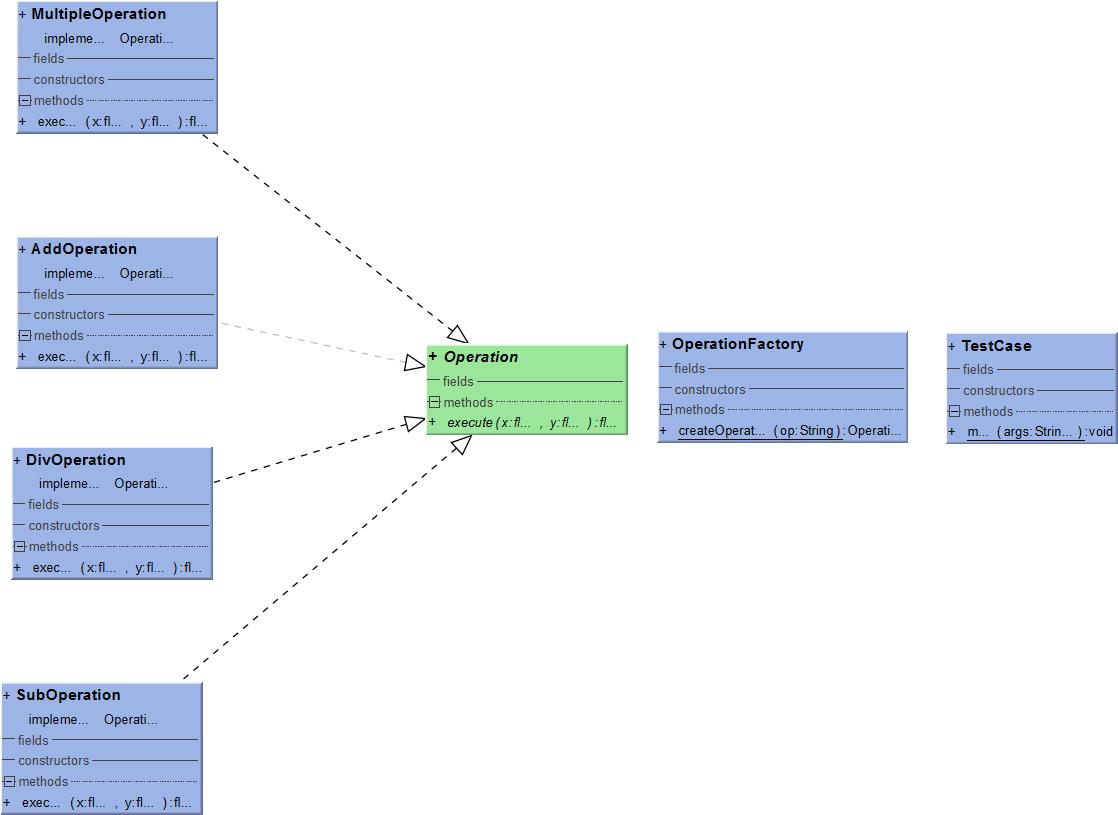@linux1s1s
2019-02-18T10:58:28.000000Z
字数 2258
阅读 1709
Base Time-Design Patterns-Factory Method
Base 2017-01
需求
- 请写一个计算加减乘除的简单程序。
面向过程
这个需求很简单,我们随手写个类,里面给个方法即可。
Calculator.java
public class Calculator {public float execute(float x, float y, String operation) {if (TextUtils.isEmpty(operation))return 0;float result;if ("+".equals(operation)) {result = x + y;} else if ("-".equals(operation)) {result = x - y;} else if ("*".equals(operation)) {result = x * y;} else if ("/".equals(operation)) {if (y == 0)result = 0;elseresult = x / y;} else {result = 0;}return result;}}
上面的程序将计算器的代码封装到一个方法中,供客户端调用,这样如果存在多个客户端,只需要调用这个方法即可,实现了代码的可复用。那么现在我们把这个工具类编译后,其他人就可以使用了,假如说现在需要添加一个新算法,求A的B次方,我们就需要修改这个类的源代码,在getResult中加入新的分支,然后重新编译,供客户端使用,难扩展。
静态工厂方法
为了解决上面的问题,我们尝试用静态工厂方法去重构。
UML类图:

源代码:
接口Operation.java
public interface Operation {float execute(float x, float y);}
实现Operation.java的具体实现子类
AddOperation.java
public class AddOperation implements Operation {@Overridepublic float execute(float x, float y) {return x + y;}}
SubOperation.java
public class SubOperation implements Operation {@Overridepublic float execute(float x, float y) {return x - y;}}
MultipleOperation.java
public class MultipleOperation implements Operation {@Overridepublic float execute(float x, float y) {return x * y;}}
DivOperation.java
public class DivOperation implements Operation {@Overridepublic float execute(float x, float y) {return x / y;}}
如果以后想增加中算法,那么只新增算法实现类,并继承接口Operation.java即可,无须修改其他的算法类。
接下来就是静态工程类的实现。
OperationFactory.java
public class OperationFactory {public static Operation createOperation(String op) {if (TextUtils.isEmpty(op))return null;Operation operation;if ("+".equals(op)) {operation = new AddOperation();} else if ("-".equals(op)) {operation = new SubOperation();} else if ("*".equals(op)) {operation = new MultipleOperation();} else if ("/".equals(op)) {operation = new DivOperation();} else {operation = null;}return operation;}}
最后看一下TestCase.java
public class TestCase {public static void main(String[] args) {float x = 3;float y = 4;String operation = "-";Operation o = OperationFactory.createOperation(operation);if (o != null) {o.execute(x, y);} else {Log.e("factory", "Operation illegal");}}}
小结
将创建对象的工作交给工厂负责,这样调用者不再和算法直接接触,有效的将使用和实现隔离开,并做到了可复用、可维护、可扩展。
我们知道面向对象有10大设计原则,其中之一是开闭原则
即对扩展开放,对修改关闭。这是另一种非常棒的设计原则,可以防止其他人更改已经测试好的代码。理论上,可以在不修改原有的模块的基础上,扩展功能。这也是开闭原则的宗旨。
如果现在有个需求,增加一种算法实现,那么不得不修改静态工厂类,并在createOperation()方法处新增一种算法的实例,很显然违背了上面的开闭原则,那么应该怎么解决这个问题呢,我们来看下面一篇博文Base Time-Design Patterns-Abstract Factory Method
参考博文:
简单工厂模式 参考和部分修改,特此说明。
